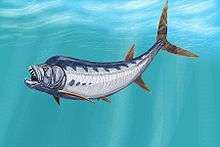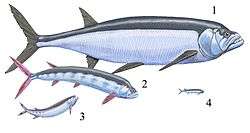Xiphactinus
| Xiphactinus Temporal range: Albian–Maastrichtian[1] | |
|---|---|
 | |
| Xiphactinus audax fossil in CosmoCaixa Barcelona | |
| Scientific classification | |
| Kingdom: | Animalia |
| Phylum: | Chordata |
| Class: | Actinopterygii |
| Superorder: | Osteoglossomorpha |
| Order: | Ichthyodectiformes |
| Family: | Ichthyodectidae |
| Subfamily: | Ichthyodectinae |
| Genus: | Xiphactinus Leidy, 1870 |
| Species | |
| |
| Synonyms | |
|
Portheus molossus Cope | |
Xiphactinus (from Latin and Greek for "sword-ray") is an extinct genus of large (4.5 to 6 m (15 to 20 feet) long) predatory marine bony fish that lived during the Late Cretaceous. When alive, the fish would have resembled a gargantuan, fanged tarpon (to which it was, however, not related).[3] The species Portheus molossus described by Cope[3] is a junior synonym of X. audax. Skeletal remains of Xiphactinus have come from Kansas (where the first Xiphactinus fossil was discovered during the 1850s),[4] and Cretaceous formations all over the East Coast (most notably Georgia, Alabama, North Carolina, and New Jersey) in the United States, as well as Europe, Australia, Canada and Venezuela.[5]
Palaeobiology


Species of Xiphactinus were voracious predatory fish. At least a dozen specimens of X. audax have been collected with the remains of large, undigested or partially digested prey in their stomachs. In particular, one 13 feet (4.0 m) fossil specimen was collected by George F. Sternberg with another, nearly perfectly preserved 6 feet (1.8 m) long ichthyodectid Gillicus arcuatus inside of it. The larger fish apparently died soon after eating its prey, most likely owing to the smaller fish prey's struggling and rupturing an organ as it was being swallowed. This fossil can be seen at the Sternberg Museum of Natural History in Hays, Kansas.[3][6]
Like many other species in the Late Cretaceous oceans, a dead or injured individual was likely to be scavenged by sharks (Cretoxyrhina and Squalicorax). The remains of a Xiphactinus were found within a large specimen of Cretoxyrhina collected by Charles H. Sternberg. The specimen is on display at the University of Kansas Museum of Natural History.
Virtually nothing is known about the larval or juvenile stages. The smallest fossil specimen of X. audax consists of a tooth bearing premaxilla and lower jaws of an individual estimated to be about 12 inches (30 cm) long.[3][7]
The species and all other ichthyodectids became extinct near the end of the Late Cretaceous – see Cretaceous–Paleogene extinction event.
An incomplete skull of what may be a new species of Xiphactinus was found in 2002 in the Czech Republic, in a small town called Šachov next to Borohrádek city, by 16 years old student Michal Matějka.
In July 2010 the bones of a Xiphactinus were discovered near Morden, Manitoba, Canada. The specimen is about six metres long and was found with the flipper of a mosasaur between its jaws.[8]
"Unicerosaurus"
In 1982, a former Baptist minister, Carl Baugh, began excavations on the limestone beds of the Paluxy River, near Glen Rose, Texas, famous for its dinosaur tracks. Some of the tracks resembled human footprints and had been proclaimed since 1900 as evidence that dinosaurs and modern humans had once lived alongside one another. Scientists' investigations found the supposed human footprints to be "forms of elongate dinosaur tracks, while others were selectively highlighted erosional markings, and still others (on loose blocks) probable carvings." While excavating, he found a solitary "Y-shaped" fossil that he informally called "Unicerosaurus". In a 1987 popular article, John Armstrong described the fossil as a "Y-shaped petrified bone that appears to be the neural spine from a huge fish like the Portheus of Niobrara Chalk" that Baugh's museum "declared to be the forehead horn of a newly discovered dinosaur genus".[9] The museum's exhibit told visitors that the "horn" belonged to "the unicorn of Job 38, one of three dinosaurs mentioned in Scripture; the others being behemoth and leviathan of Job 40 and 41", and that the horn was able to fold back like the blade of a jack knife. Although some Young Earth Creationists shared Baugh's interpretations of the biblical Behemoth and Leviathan, Baugh's claims were not taken seriously either by Christian organizations nor the scientific community.
In popular culture
In October 2010, Kansas House Rep. Tom Sloan (R-Lawrence) announced that he would introduce legislation to make Xiphactinus audax, a.k.a. the "X-fish", the state fossil of Kansas.[10]

References
- ↑ Sepkoski, Jack (2002). "A compendium of fossil marine animal genera". Bulletins of American Paleontology. 364: 560. Archived from the original on July 23, 2011. Retrieved 2009-02-27.
- ↑ Schwimmer, David R.; Stewart, J. D.; Williams, G. Dent (1997). "Xiphactinus vetus and the Distribution of Xiphactinus Species in the Eastern United States". Journal of Vertebrate Paleontology. 17 (3): 610–15. doi:10.1080/02724634.1997.10011007. JSTOR 4523841.
- 1 2 3 4 "Xiphactinus audax Leidy"
- ↑ Haines, Tim; Chambers, Paul (2005). The complete guide to prehistoric life (First ed.). Buffalo, N.Y.: Firefly Books. p. 134. ISBN 978-1-55407-181-4.
The first Xiphactinus fossil was found during the 1850s in Kansas.
- ↑ Carrillo-Briceño, J., Alvarado-Ortega, J. & Torres, C. (2012). Primer registro de Xiphactinus Leidy, 1870, (Teleostei: Ichthyodectiformes) en el Cretácico Superior de América del Sur (Formación La Luna, Venezuela). Revista Brasilera de Paleontología 15(3):327-335
- ↑ "Xiphactinus Audax" (JPG). Sternberg Museum of Natural History. (archived: oceansofkansas.com).
- ↑ "Xiphactinus Audax" (JPG). oceansofkansas.com.
- ↑ "Major Fossil Discovery Underway in Morden" (PDF). Canadian Fossil Discovery Centre. July 16, 2010. Press release.
- ↑ Armstrong, John R. (1987). Creation/Evolution Newsletter 7 5:21; Geolog. 16, Part 4.
- ↑ "Kansas Rep. Tom Sloan agrees to back X-fish as state's official fossil / LJWorld.com". .ljworld.com. Associated Press. 2010-10-26. Retrieved 2011-10-12.
Further reading
- Bardack, David (1965). "Anatomy and evolution of chirocentrid fishes". The University of Kansas Paleontological Contributions. 40 (10): 1–88. hdl:1808/3814.
- Cope, E. D. 1871. On the fossil reptiles and fishes of the Cretaceous rocks of Kansas. Art. 6, pp. 385–424 (no figs.) of Pt. 4, Special Reports, 4th Ann. Rpt., U.S. Geol. Surv. Terr. (Hayden), 511 p. (Cope describes and names Portheus molossus)
- Cope, E. D. 1872a. On Kansas vertebrate fossils. American Journal of Science, Series 3, 3(13):65.
- Cope, E. D. 1872b. On the geology and paleontology of the Cretaceous strata of Kansas. Preliminary Report of the United States Geological Survey of Montana and Portions of the Adjacent Territories, Part III – Paleontology, pp. 318–349.
- Cope, E. D. 1872c. [Sketch of an expedition in the valley of the Smoky Hill River in Kansas]. Proc. Amer. Phil. Soc. 12(87):174-176.
- Cope, E. D. (1871). "On the Families of Fishes of the Cretaceous Formation of Kansas". Proceedings of the American Philosophical Society. 12 (86): 327–57. JSTOR 981715.
- Everhart, Michael J. 2005. Oceans of Kansas – A Natural History of the Western Interior Sea. Indiana University Press, 320 pp.
- Hay, O. P. (1898). "Observations on the Genus of Fossil Fishes Called by Professor Cope, Portheus, by Dr. Leidy, Xiphactinus". Zoological Bulletin. 2 (1): 25–54. doi:10.2307/1535460.
- Hay, O. P. 1898. Observations on the genus of Cretaceous fishes called by Professor Cope Portheus. Science, 7(175):646.
Hay noted, "Professor O. P. Hay made some 'Observations on the genus of Cretaceous Fishes, called by Professor Cope Portheus " discussing the osteology of the genus at some length and particularly the skull, shoulder girdle and vertebral column. He said that in many respects it resembled the Tarpon of our Southern coasts, although possessing widely different teeth, and undoubtedly belonged to the Isospondyli. The conclusion reached that Cope's Portheus is identical with the earlier described genus Xiphactinus of Leidy. (Since the paper was read, the author has learned that Professor Williston has reached the same conclusion.)"
- Leidy, J. 1856. Notices on remains of extinct vertebrated animals of New Jersey, collected by Prof. Cook of the State Geological Survey under the Direction of Dr. W. Kitchell. Proceedings of the Academy of Natural Sciences of Philadelphia, 8:221. (printed in 1857 – Naming of Polygonodon vetus, a sister species of Xiphactinus audax, and Ischyrhiza mira Leidy)
- Leidy, Joseph (1865). "Cretaceous Reptiles of the United States". Smithsonian Contributions to Knowledge. 14 (6): 1–135. LCCN s13000065. OCLC 3612665.
- Leidy, J. 1870. [Remarks on ichthyodorulites and on certain fossil Mammalia.]. Proceedings of the Academy of Natural Sciences of Philadelphia. 22:12-13. (The naming of Xiphactinus audax from a fragment of a pectoral fin found by Dr. George M. Sternberg (then an Army Surgeon serving in Kansas) in the chalk of western Kansas --- this paper pre-dates Cope's 1872 description of Portheus molossus by over a year).
- Osborn, Henry Fairfield (1904). "The great Cretaceous fish Portheus molossus Cope". Bulletin of the American Museum of Natural History. 20 (31): 377–81. hdl:2246/1458.
- Rogers, Katherine L. (1991). The Sternberg fossil hunters: a dinosaur dynasty. Missoula: Mountain Press Publishing. ISBN 978-0-87842-300-2.
- Schwimmer, David R.; Stewart, J. D.; Williams, Dent (1997). "Xiphactinus vetus and the Distribution of Xiphactinus Species in the Eastern United States". Journal of Vertebrate Paleontology. 17 (3): 610–5. doi:10.1080/02724634.1997.10011007. JSTOR 4523841.
- Shimada, K. and M. J. Everhart. 2004. Shark-bitten Xiphactinus audax (Teleostei: Ichthyodectiformes) from the Niobrara Chalk (Upper Cretaceous) of Kansas. The Mosasaur 7, p. 35-39.
- Sternberg, Charles Hazelius (1917). Hunting dinosaurs in the bad lands of the Red Deer River, Alberta, Canada: a sequel to The life of a fossil hunter. Lawrence, Kansas: Charles H. Sternberg.
- Sternberg, Charles H. (1922). "Field work in Kansas and Texas". Transactions of the Kansas Academy of Science. 30: 339–41. doi:10.2307/3624079.
- Stewart, A. 1898. Individual variations in the genus Xiphactinus Leidy. Kansas Univ. Quar. 7(3):116-119, pl. VII, VIII, IX, X.
Stewart placed a short note on page 116 acknowledging that Xiphactinus Leidy 1870 has priority over Portheus Cope 1872. "Xiphactinus audax Leidy (Proc. Acad. Sci. Phila., 1870, p. 12) has been shown to the a synonym of Saurocephalus Cope (U.S. Geol. Surv., Wyoming, etc. 1872, p. 418). In a letter to Prof. Mudge, dated October 28, 1870, which will shortly be published in the fourth volume of the Kansas University Geological Survey, Cope refers it to Saurocephalus thaumas (Portheus thaumas Cope). After carefully comparing the description and figure of the pectoral spine of X. audax I was led to the same conclusion; and as the genus Portheus was not made known by Cope until 1871 (Proc. Am. Phil. Soc., 1871, p. 173), according to the rules of nonclamature Xiphactinus should have priority."
- Stewart, Alban (1899). "Notice of Three New Cretaceous Fishes, with Remarks on the Saurodontidae Cope". The Kansas University Quarterly. 8 (3): 107–12.
- Stewart, Alban (1900). "Teleosts of the Upper Cretaceous". Reports. Kansas Geological Survey. 4: 257–507.
- Stovall, J. W. 1932. Xiphactinus audax, a fish from the Cretaceous of Texas. University of Texas Bulletin No. 3201:87-92, 1 pl.
- Thorpe, M. R. (1934). "A newly mounted specimen of Portheus molossus Cope". American Journal of Science. s5-28 (164): 121–6. doi:10.2475/ajs.s5-28.164.121.
- Walker, M.V. 1982. The Impossible Fossil. University Forum, Fort Hays State University 26: 4pp.
- Walker, Myrl V.; Everhart, Michael J. (2006). "The Impossible Fossil – Revisited". Transactions of the Kansas Academy of Science. 109: 87–96. doi:10.1660/0022-8443(2006)109[87:TIFR]2.0.CO;2. ISSN 0022-8443.
External links
| Wikimedia Commons has media related to Xiphactinus. |